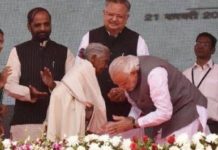By Siddharth Aiyanna (NALSAR, Batch of 2020)
Nepal seemingly has reason to rejoice after having avoided a deadlock in the Constituent Assembly over approval of the newly drafted constitution, especially after seven long years marred by political infighting. September 16th saw the Constituent Assembly approve not only all articles but also the Preamble of the new constitution. The Assembly, with 601 seats included representatives from Nepali Congress, Unified Communist Party of Nepal (UCPN), Communist Party of Nepal Unified Marxist-Leninist (CPN-UML) as well as representatives of other ethnic minority groups, and passed the new statute by a 507-25 vote thereby crossing the requisite 2/3rd mark of majority with ease. The dissenting votes all belonged to members of Rastriya Prajatantra Party Nepal, a pro-Hindu and pro-monarchist party, evidently unhappy with the statute for declaring Nepal to be a secular state. Smaller opposition parties and most of the Madhes-based parties boycotted the voting process altogether.
The new charter is set to replace the interim constitution in accordance with which the country has been governed since 2007 and affirms Nepal to be a federation of seven states, each with its own legislature and chief minister. On being signed by the lawmakers and authenticated by Subas Chandra Nembang, the Chairperson of the Constituent Assembly, the bill will become the new charter of Nepal. Accordingly the new constitution is likely to commence on Sunday, September 20th, 2015, post which the promulgation of the new constitution will be announced by President Ram Baran Yadav via the sovereign body elected by the people. Sushil Koirala has also declared in the interim, his intentions to abdicate his Prime Minister-ship to pave the way for a new government once the Constitution comes into force, signalling an imminent change in the political order.
Background:
The culmination of the Nepalese Civil War between the government and Maoist rebels in 2006 saw the ouster of King Gyanendra and the monarchy he stood for, paving the way for a ‘people’s republic.’ The earlier practice wherein commissions approved by the king wrote the constitution was scrapped and a Constituent Assembly was elected in 2008 in the interest of democracy to draft a new Constitution for the Himalayan nation, it also served as Nepal’s interim parliament. The endeavours of the original assembly being largely ineffective, a second Constituent Assembly was elected in 2013. The progress of both Assemblies had been impeded by political infighting, making the wait for the new Constitution arduously long. The parties in the fray failed to reach a consensus on several issues including the names, numbers and forms of governance under the proposal to create new states as well as on electoral and judicial processes which consequently, albeit regrettably, resulted in a delay in the framing of the new charter. The 2013 Assembly elections brought about an upheaval in the political order by bringing to power a coalition government between the Nepali Congress and CPN-UML under the leadership of Sushil Koirala. The new government took up the task of promulgating the novel constitution that the erstwhile rebel Maoist regime had failed to deliver, however the lack of political will compounded by vested interests of various parties ensured slow progress. The three major political parties received an impetus to begin drafting the constitution in June this year, when the constitutional logjam was widely criticized for delaying rescue efforts in the recent barrage of earthquakes that struck Nepal.
Public Response:
The constitution has been a cause for concern on various fronts with multiple ethnic groups vehemently opposing the primary points established by the statute. Firstly, the composition, borders and size of the proposed states have been questioned with demands for more states on ethnic grounds being made while allocating areas proportionate to the size of the group. Calls are also being made seeking an assurance that minority groups will receive more seats for adequate representation in the parliament and government. The Tharu and Madhesi communities which are ethnographically similar to Indians are particularly concerned that the new charter will give room for their persecution and further marginalization in society and continue their protests against what they perceive to be an attempt by big parties to crush the minority groups.
Secondly, there is staunch opposition by groups to the institutionalization of secularism in Nepal with many clamouring for its reinstatement as a Hindu state. In keeping with all of the above, several smaller opposition parties have called for strikes where copies of the new Constitution will be burned. The outcry over these issues recently saw violent protests that left 44 people, including policemen dead. The strikes and protests called for have resulted in a complete shutdown of large parts of Nepal and blockades have slowed down food and cargo deliveries to Kathmandu. The rejection of a proposal to revert to the status of a Hindu state also led to the persecution of other religious communities with several low intensity blasts in churches creating an atmosphere of panic.
Resentment fortunately is not the only emotion the Nepalese experience when thinking of the new Constitution. Several of them, particularly those in Kathmandu express relief at the coming of force of the constitution. Others believe that the progress of the nation cannot be held hostage in the interest of a few minorities and add that it is impossible for the constitution to keep everybody in the country happy.
The Government’s Stance
The government is unwilling to delay the promulgation of the constitution in order to accommodate the interests of the disgruntled parties while maintaining that the constitution incorporates best practices of governance from the world over. Spokespersons within the government maintain that they remain open to discourse on the drafted proposals. The action taken by the government so far deplorably seems to reflect a lack of willingness to do so. With opposition parties claiming that their concerns and opinions were ignored and a curfew having been imposed along with the deployment of military forces, the government’s stance is hard to believe. Further, proposals for amendments have been side-lined in the interest of expedient enforcement of the constitution. The government further believes that the constitution is inclusive and entails affirmative action for several minority communities including women and is therefore inherently progressive. The major reforms undertaken have been in the interest of i) administrative efficacy and ii) inclusivity of religious minorities. In pursuance of understanding the reasons for the same, it is important to note the religious breakup within the demography According to survey in 2011, 81.2% of Nepal was Hindu, 9.0% was Buddhist, 4.4% was Muslim and 1.42% was Christian while the remaining belonged to other faiths. Thus declaring Nepal to be secular was a conscious effort to shatter the notion that the government was pandering only to the majority.
Looking forward:
As it stands, the introduction of the new Constitution has the potential to shape Nepal’s future for better or worse in the years to come. The protests cannot be viewed myopically as the governmental action or reaction to them could possibly give way to a long-drawn and bitter internal conflict. On that note, the keenness of officials to proceed with the enactment of the new statute without getting the Tharu and Madhesi communities on board does not bode well for Nepal.
Unlike in India where there was a shift from a colony to an independent state, Nepal is transitioning from an independent Hindu state to a secular state. This is a big jump in itself as it is a change motivated by internal elements and factors and sheds light on the concerns going forward. The very use of the word ‘secular’ puts everyone on an equal footing which is in direct contrast to the notion of it being a Hindu state wherein the majority of the population is prioritized either consciously or subconsciously as the primary stakeholder while framing most new laws. The use of the word secular is thereby likely to amend the manner and phraseology of laws evolved henceforth. The difference is likely to be tangible specifically for the Hindu populace, thereby instilling insecurity in them. Thus the evolution of the word secular in itself is likely to bring about an overhaul of society which from a Marxist perspective, is rarely unaccompanied by competition of conflict amongst the various groups internally.
From the response that has been generated so far, the path Nepal will take is uncertain. However in light of recent developments, it can safely be assumed that the new charter will achieve neither the goal of administrative efficacy nor will it lead to the inclusion of minorities in society, at least in the near future. The onus therefore falls on the shoulders of the government to redress all elements left disgruntled by the provisions of the new constitution, even if they comprise a mere minority and ensure that the new charter confers them with a sense of belonging as opposed to a notion of alienation.














